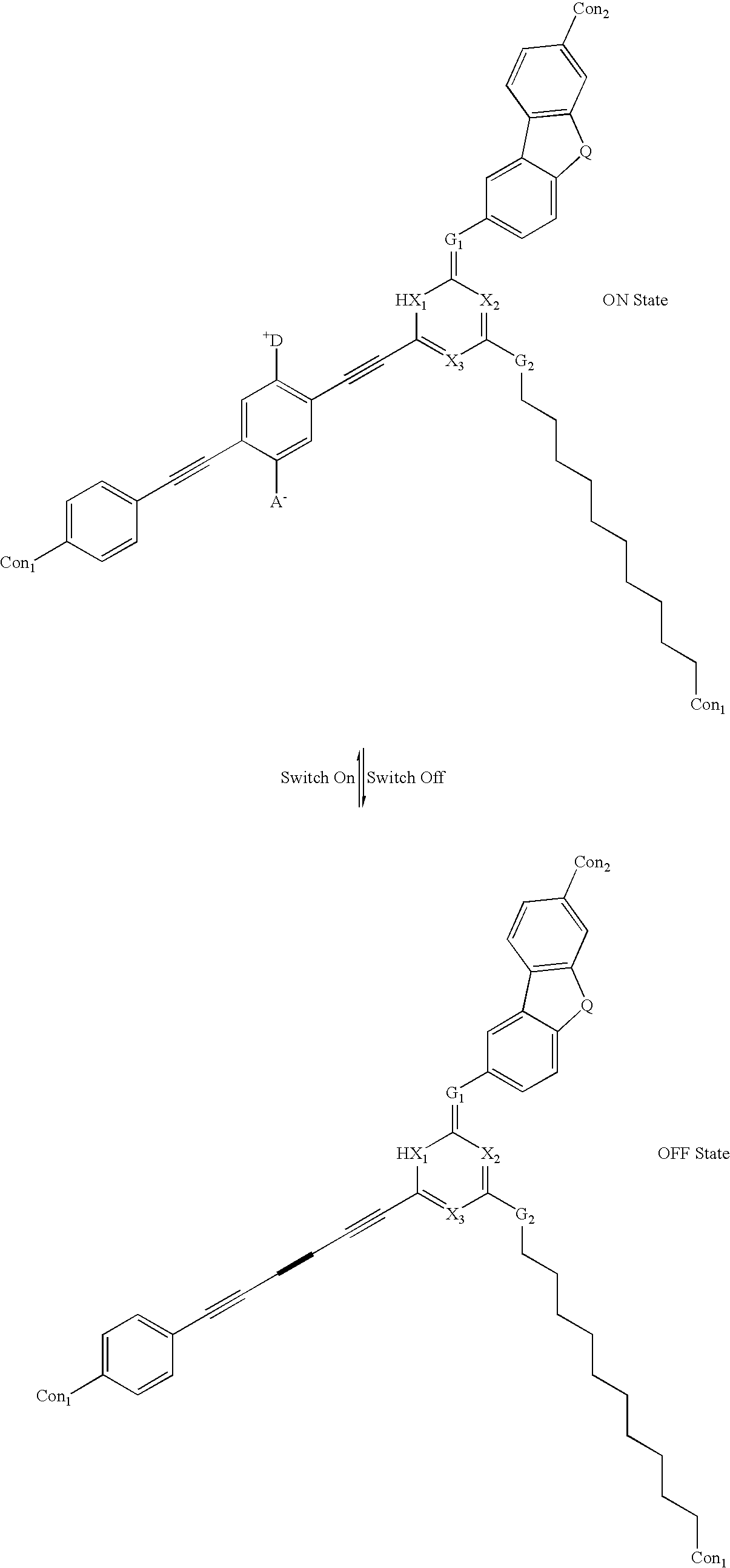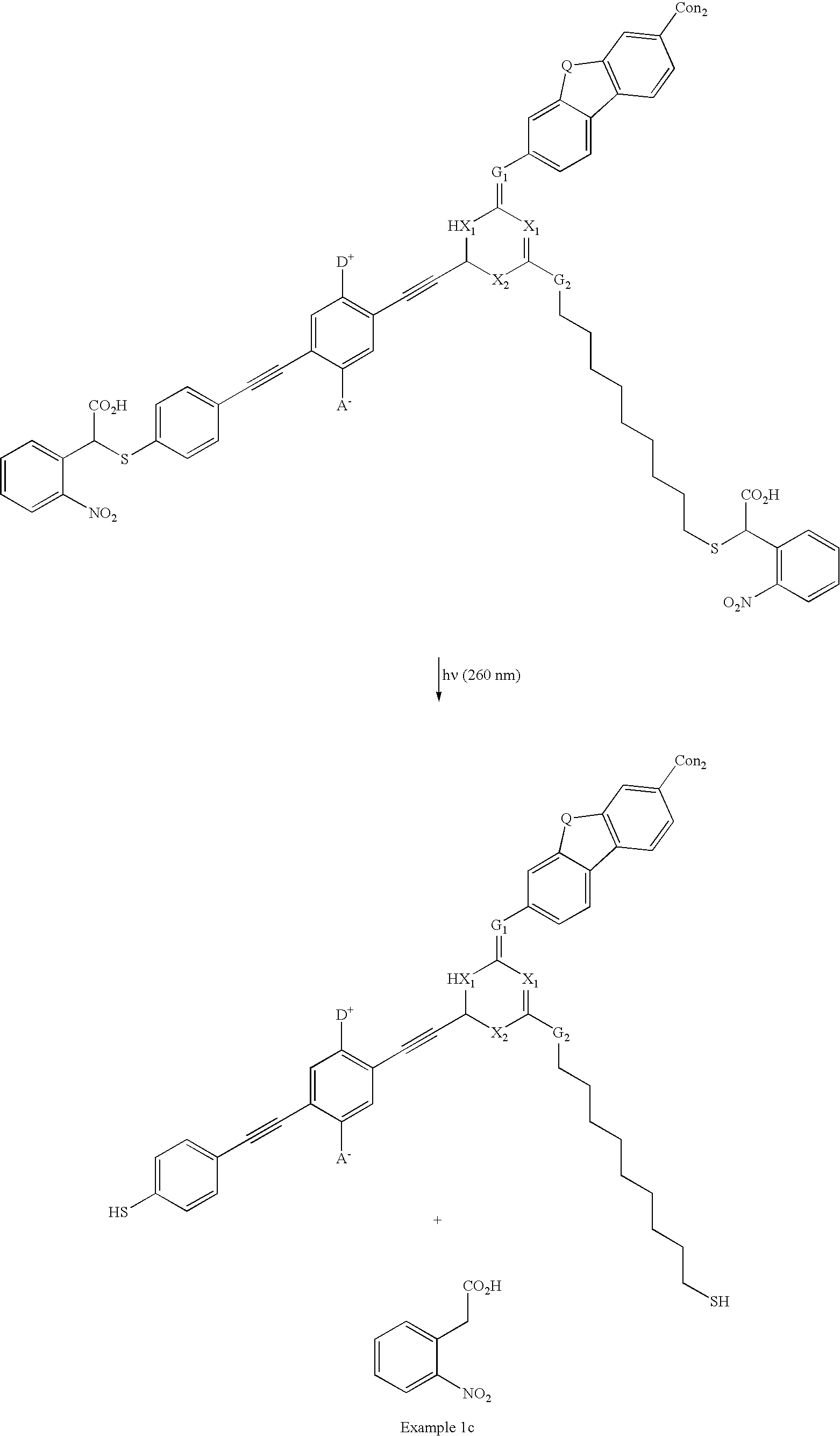Photopatternable molecular circuitry
a molecular circuit and molecular technology, applied in the field of photopatternable molecular circuitry, can solve the problems of adversely altering the properties of ultra-thin junctions, essentially unremovable/inseparable, barrier materials between molecule and conventional resist, etc., to simplify the fabrication of micro-scale and nano-scale circuits, reduce or eliminate conventional photoresist masking layers, and simplify traditional processes
- Summary
- Abstract
- Description
- Claims
- Application Information
AI Technical Summary
Benefits of technology
Problems solved by technology
Method used
Image
Examples
example 1b
[0090] where:
[0091] The symbol A.sup.- is an Acceptor group; it is an electron-withdrawing group. It may be one of following: carboxylic acid or its derivatives, sulfuric acid or its derivatives, phosphoric acid or its derivatives, nitro, nitrile, hetero atoms (e.g., N, O, S, P, F, Cl, Br), functional group with at least one of above-mentioned hetero atoms (e.g., OH, SH, NH, etc.), hydrocarbons (either saturated or unsaturated), or substituted hydrocarbons.
[0092] The symbol D.sup.+ represents a Donor group; it is an electron-donating group. It may be one of following: hydrogen, amine, OH, SH, ether, hydrocarbon (either saturated or unsaturated), substituted hydrocarbon, or a functional group with at least one of hetero atom (e.g., B, Si, I, N, O, S, P). The donor is differentiated from the acceptor by that fact that it is less electronegative, or more electropositive, than the acceptor group on the molecule.
[0093] The designations Con.sub.1 and Con.sub.2 represent connecting units b...
example 1c
[0111] Example 1c below shows a real molecular example of another embodiment of the present invention. In Example 1c, the device contains two photosensitive connecting groups. Upon irradiation, e.g., UV, the connecting groups decompose to form thiol and 2-nitrophenylacetic acid, which is removable by washing with a base. 2
[0112] where:
[0113] The symbol A.sup.- is an Acceptor group; it is an electron-withdrawing group. It may be one of following: carboxylic acid or its derivatives, sulfuric acid or its derivatives, phosphoric acid or its derivatives, nitro, nitrile, hetero atoms (e.g., N, O, S, P, F, Cl, Br), functional group with at least one of above-mentioned hetero atoms (e.g., OH, SH, NH, etc.), hydrocarbons (either saturated or unsaturated), or substituted hydrocarbons.
[0114] The symbol D.sup.+ represents a Donor group; it is an electron-donating group. It may be one of following: hydrogen, amine, OH, SH, ether, hydrocarbon (either saturated or unsaturated), substituted hydroca...
example 2a
[0121] where:
[0122] The symbol A.sup.- is an Acceptor group; it is an electron-withdrawing group. It may be one of following: hydrogen, carboxylic acid or its derivatives, sulfuric acid or its derivatives, phosphoric acid and its derivatives, nitro, nitrile, hetero atoms (e.g., N, O, S, P, F, Cl, Br), or a functional group with at least one of above-mentioned hetero atoms (e.g., OH, SH, NH, etc.), or hydrocarbon (either saturated or unsaturated) or substituted hydrocarbon.
[0123] The symbol D.sup.+ represents a Donor group; it is an electron-donating group. It may be one of following: hydrogen, amine, OH, SH, ether, hydrocarbon (either saturated or unsaturated), substituted hydrocarbon, or a functional group with at least one hetero atom (e.g., B, Si, I, N, O, S, P). The donor is differentiated from the acceptor by that fact that it is less electronegative, or more electropositive, than the acceptor group on the molecule.
[0124] The items; G.sub.1.dbd.G.sub.2, G.sub.3.dbd.G.sub.4, G.s...
PUM
| Property | Measurement | Unit |
|---|---|---|
| thickness | aaaaa | aaaaa |
| size | aaaaa | aaaaa |
| thick | aaaaa | aaaaa |
Abstract
Description
Claims
Application Information
 Login to View More
Login to View More - R&D
- Intellectual Property
- Life Sciences
- Materials
- Tech Scout
- Unparalleled Data Quality
- Higher Quality Content
- 60% Fewer Hallucinations
Browse by: Latest US Patents, China's latest patents, Technical Efficacy Thesaurus, Application Domain, Technology Topic, Popular Technical Reports.
© 2025 PatSnap. All rights reserved.Legal|Privacy policy|Modern Slavery Act Transparency Statement|Sitemap|About US| Contact US: help@patsnap.com



